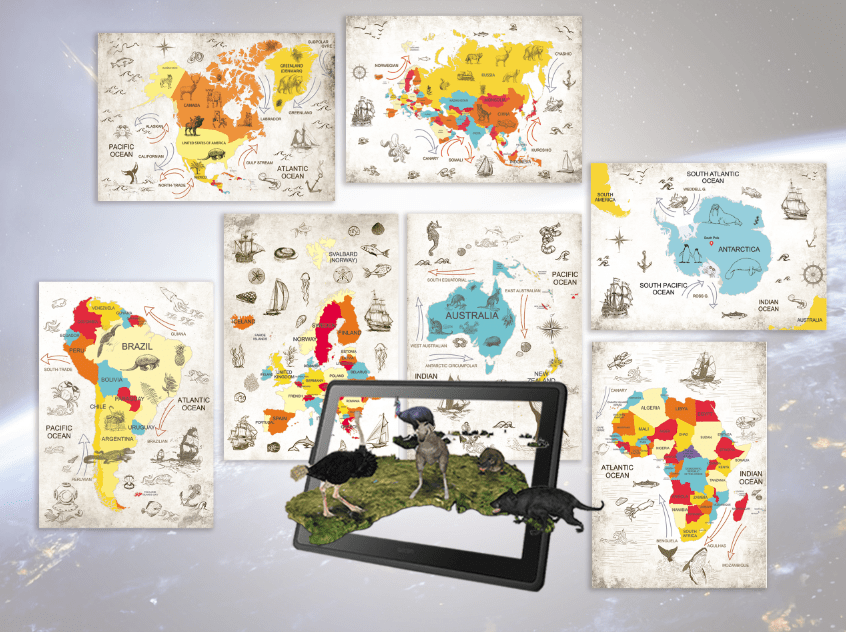Augmented reality is transforming education, but success depends on matching AR content middle school and primary school students to their developmental stage. When educators understand how children’s cognitive abilities evolve from kindergarten through eighth grade, they can harness AR’s immersive power while avoiding cognitive overload and frustration.
The Developmental Foundation: Why Age Matters in AR Education
Children’s brains develop in predictable patterns, with critical implications for K-8 AR curriculum design. Elementary students think concretely and benefit from AR experiences that make abstract concepts tangible—like watching dinosaurs walk through their classroom or manipulating 3D geometric shapes with their hands. Middle schoolers, with emerging abstract thinking skills, can handle more complex AR scenarios that require hypothesis formation and multi-step problem solving.
Research from the Journal of Educational Technology & Society shows that age-inappropriate AR content can actually hinder learning by overwhelming working memory. Students spend mental energy wrestling with interface complexity instead of engaging with educational content. The solution lies in progressive complexity that grows with students’ capabilities.
Kindergarten Through Grade 2: Building Wonder and Basic Skills
Developmental Profile: Concrete thinkers who learn through sensory exploration and need immediate feedback.
AR Content Strategy: Simple, colorful experiences with clear cause-and-effect relationships. Primary school augmented reality works best when it feels like guided play.
Practical Applications:
- Letter Recognition: AR alphabet animals that appear when students point devices at letter cards, with each animal performing a simple action
- Number Concepts: Virtual counting bears that students can touch to hear numbers spoken aloud
- Science Exploration: Weather AR that shows rain, snow, or sunshine overlaid on classroom windows
- Story Enhancement: Character animations that bring picture books to life without overwhelming the narrative
Implementation Guidelines: Sessions should last 10-15 minutes maximum. Provide clear visual cues for interaction points and minimize text-based instructions. Success indicators include sustained attention and spontaneous verbal responses about what students observe.
Grades 3-5: Developing Investigation Skills
Developmental Profile: Beginning abstract thinking with improved attention spans and growing comfort with technology interfaces.
AR Content Strategy: Interactive explorations that encourage observation, comparison, and basic hypothesis formation. Students can handle multi-step activities with clear progression markers.
Practical Applications:
- Solar System Exploration: Scale models of planets that students can walk around, comparing sizes and distances
- Historical Immersion: Revolutionary War battle maps overlaid on classroom floors, with timeline controls students manipulate
- Anatomy Learning: 3D skeletal and organ systems that students can layer and examine from multiple angles
- Ecosystem Simulation: Food chain interactions where students observe predator-prey relationships in virtual environments
Implementation Guidelines: 20-30 minute sessions work well. Include collaborative elements where students share discoveries. Provide reflection prompts that connect AR experiences to prior knowledge.
Grades 6-8: Advanced Problem-Solving and Abstract Thinking
Developmental Profile: Developing formal operational thinking with capacity for hypothesis testing, variable manipulation, and complex reasoning.
AR Content Strategy: Open-ended explorations with multiple solution paths. AR content middle school students encounter should challenge them to analyze, synthesize, and evaluate information.
- Chemistry Visualization: Molecular modeling where students build compounds and observe reactions at atomic levels
- Engineering Challenges: Bridge-building simulations with physics constraints students must consider
- Geographic Analysis: Layered demographic, climate, and economic data students examine to understand regional characteristics
- Literary Analysis: Character relationship networks and thematic connections visualized in 3D space
Implementation Guidelines: 45-minute sessions allow for deep engagement. Include opportunities for students to create and share their own AR content. Assessment should focus on process and reasoning rather than single correct answers.
Curriculum Alignment Strategies That Actually Work
Successful K-8 AR curriculum integration requires intentional alignment with learning standards while preserving AR’s unique advantages. Rather than forcing AR into existing lesson plans, effective educators identify where AR naturally enhances learning objectives.
Standards-Based Planning: Start with specific learning standards, then identify concepts that benefit from spatial visualization, temporal manipulation, or scale changes. AR excels at making microscopic phenomena visible, bringing historical events into present space, and allowing manipulation of dangerous or expensive materials.
Assessment Integration: Traditional assessments often fail to capture AR learning gains. Effective approaches include portfolio documentation of AR-created artifacts, peer explanation activities where students teach others using AR tools, and reflection journals connecting AR experiences to conceptual understanding.
Professional Development Framework: Teachers need hands-on experience with age-appropriate AR tools before classroom implementation. Successful programs provide grade-level specific training that models effective pedagogical approaches rather than focusing solely on technical skills.
Practical Implementation: From Vision to Classroom Reality
Technology Considerations: Device management significantly impacts learning outcomes. Elementary students benefit from shared devices with teacher-controlled content loading. Middle school students can handle individual devices but need clear protocols for on-task behavior.
Content Curation: Quality matters more than quantity. A few well-designed AR experiences aligned with curriculum goals outperform extensive libraries of poorly integrated content. Prioritize AR applications with educational research backing and clear learning objective alignment.
Scaffolding Strategies: Introduce AR gradually. Begin with teacher-led demonstrations, progress to guided small group exploration, then move toward independent investigation. This progression builds both technical competence and learning strategy development.
Measuring Success: Evidence-Based Outcomes
Effective age-appropriate AR education produces measurable learning gains. Research indicates that well-implemented primary school augmented reality increases retention rates by 35% compared to traditional instruction methods. Middle school implementations show particular strength in spatial reasoning development and scientific inquiry skills.
Key Performance Indicators:
- Student engagement duration and quality of on-task behavior
- Conceptual understanding demonstrated through multiple assessment formats
- Transfer of learning to non-AR contexts
- Student-generated questions and investigation proposals
- Collaborative learning quality during AR activities
Moving Forward: Your Next Steps
Implementing age-appropriate AR content requires systematic planning but delivers transformative educational outcomes. Begin by identifying one curriculum area where spatial visualization or interactive modeling would enhance student understanding. Pilot with a small group, document student responses, and refine before broader implementation.
The future of K-8 education increasingly includes augmented reality, but success depends on matching content complexity to developmental readiness. Students deserve AR experiences that challenge their growing capabilities while respecting their cognitive limitations. When we get this balance right, AR becomes a powerful tool for deeper learning rather than just technological novelty.
Start small, focus on learning objectives, and let student engagement guide your expansion efforts. The most effective AR implementations grow organically from successful foundation experiences rather than attempting comprehensive transformation all at once.

